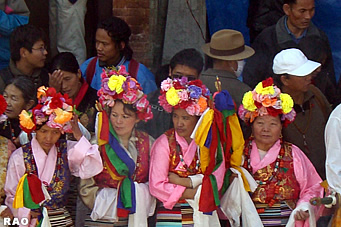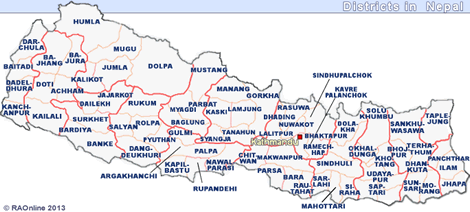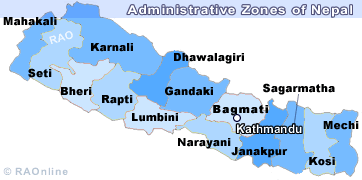 |
Nepal SOCIAL LIFE |
 |
Nepal Information |
|
|
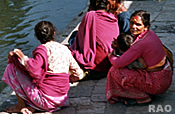 |
|
Nepal
's Indigenous Nationalities
|
 |
Nepal
has a population of more than 27 millions, made of different races and
tribes. The Gurungs and Magars live mainly in the west and the southern
slopes of Annapurna, Himalchuli and Ganesh Himal mountains.
 |
| The Rais,
Limbus and Sunuwars inhabit also the slopes and valleys of eastern
mid hills.
The Sherpas live in the Himalayan region up to an average altitude of 4570 m.
The Newars constitute an important ethnic group in the capital valley of Kathmandu.
There
are Tharus, Yadavas, Satar, Rajvanshis and Dhimals in the
Terai region.
The Brahmans, Chhetris and Thakuris are spread generally over most parts
of the Kingdom. |
|
Many
different ethnic groups have their own languages for dialects, but Nepali,
the national language, written in Devenagari script, serves purposes of
the the Kingdom's lingua franca in Nepal. The educated people speak and
understand English as well.
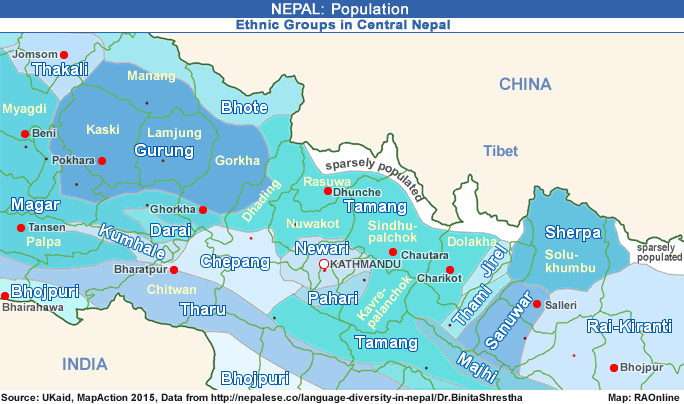 |
Baramu
(or Baram)
Baramu
people are mostly found in Gorkha and Tanahun districts. They are also
found in Dhading, Makwanpur and Lalitpur districts. Their popular myth
of origin connects them with Sunuwars, Surel, Jirel, Rais and Limbus, other
indigenous nationalities of eastern Nepal. They have their own language
that belongs to the Tibeto-Burman family. They are animists, but they are
coerced to state Hinduism as their religion.
Bhujel
Baramu
people are mostly found in Gorkha and Tanahun districts. They are also
found in Dhading, Makwanpur and Lalitpur districts. The Bhuji and Nishi
area in Baglung are considered the ancestral place of the Bhujels. Nowadays
they are scattered all over Nepal. Culturally and historically, they are
close to the Magars. The religion and culture of these backward people
are close to extinction, and Hindu influences have been encroaching on
their ways of life.
Chepang
The
Chepangs are found in the remote and sparse contours, outback and rolling
precipices of the districts of Makwanpur, Chitwan, Gorkha and Dhading districts.
They have their own distinct language, which belongs to one of the Tibeto-Burman
strains. It is felt that their religion and culture are influenced by the
Tamangs.
Chhantyal
Chantyals
are found concentrated in some villages of Myagdi, Baglung and Mustang
districts. The culture and habits resemble those of the Magars. The Chhantyals
are animists and profess shamanism.
Dura
Duras
live on the hills of Dura Danda, Turlungkot, Kunchha Am Danda of Lamjung
District and some adjacent villages of Tanahun district. Their Language
is also called Dura but it is near extinction. Animistic practices are
common to them.
Free
(Phree)
The
Freeare living in the districts of Sindhupalchok, Kavrepalanchok, Makawanpur
and Lalitpur. Their languages are close with the language of the Newars.
The culture and rituals of Free have more affinity with those of Pahari,
although they appear to be influenced by the culture of Newars and Tamangs.
Gurung
the
main habitats of the Gurungs are the districts of Kaski, Lamjung, Gorkha,
Syangja, Mustang, Manang and Dhading in the Gandaki Zone while they are
also scattered in Okhaldhunga, Sankhuwasabha and Taplejung districts. They
speak languages related to the Mon-Khmer and Tibeto-Burman lineages. Gurungs
are predominantly Buddhists.
Hayu
Hayus
are another endangered indigenous peoples of Nepal, numbering a few hundred
families. They live along the neighborhoods of the Maryang River, and they
are also found in the districts of Sindhuli and Ramechhap. They are animists
or nature worshippers, though they are highly influenced by neighboring
Hindus.
Jirel (Jiripa)
The
Jirel people are settled in Dolakha and Sindhupalchowk districts. Jirels
are close to Sherpa linguistically. The language of Jirels is of Tibeto-Burman
family. Jirels follow Buddhist religion and their priest is called Lama.
Kushbadia
(Kuhbadia)
Kushbadia
people are found in Banke and Bardiya districts. They are nature worshippers
. They have their own social organisation.
Kusunda
Sparsely
found in the districts of Gorkha, Kaski, Salyan, Pyuthan, Dang, Dailekh
and Surkhet, the Kusundas resemble the Chepangs in their observances. They
have their own language. The Kusundas are worshippers of nature.
Larke
(Nupriba)
Larkes
live in Larke, which is in the northern border region of Gorkha district
and to the west of Siyar, another northern part of Gorkha district. Their
religion and culture are influenced by Tibet Autonomous Region of China
in the north, and there is also much cultural commonality with the Sherpas
of Solukhumbu.
Lepcha
Lepchas
presently live in the Ilam District of Nepal, and in Sikkim, Darjeeling
and Kalimpong of India. They have their own script, and their holy scripture
is called Astachyo. Animist in origin, many Lepchas now adhere to Buddhism
and Christianity.
Limbu
Limbus
live and work in the districts of Sankhuwasabha, Tehrathum, Dhankuta, Taplejung,
Panchthar and Ilam. Limbus have their own script called Sirijunga. Limbus
have their own distinct culture. They have their own religion called Kirat
Dharma.
Magar
Magar
is the largest group among the indigenous peoples and nationalities of
Nepal. They are settled mainly in Palpa, Gulmi, Myagdi, Rukum, Salyan and
Rolpa. Magars have their own language which belongs to the Tibeto-Burman
family and has three divisions called Kham, Kaike and Magarati.
Pahari
The
minority group of Paharis is mainly found in the villages of Khopasi, Saldhara
and Palanchok of Kavrepalanchok District. Paharis have their own Pahari
language, which is quite akin to the Tamang and Newar languages.
Rai
Rais
are living in the districts of Solukhumbu, Okhaldhunga, Khotang, Bhojpur
and Udaypur. Rais speak many dialects of the Tibeto-Burman family. They
have their own unique religion
Sunuwar
Sunuwars
live in the land between the Likhu and Khimti rivers and in the districts
of Okhaldhunga, Ramechhap and Dolkha. They have their own unique language
and culture.
Surel
Surel
people settled from time immemorial in the villages of Suri Haleswari,
Tinekhu and Khahare in the vicinity of Suri Khola in Dolakha district.
The language of Surels belongs to the Tibeto-Burman family and it resembles
the language of Sunuwars.
Tamang
Tamangs
are mainly found in the districts of Rasuwa, Sindhupalchok, Kavrepalanchok,
Makwanpur, Nuwakot, Dhading, Ramechhap, Dolkha and Sindhuli. The Tamang
language, culture and traditions are rich.
Thami
Thamis
are mainly found in Suspa, Chhemawati, Khopachagu, Alampu, Bigu, Kalinchok,
Lapilang and Lakuri Danda villages of Dolakha district. The Thami language
is similar to the language of the Sunuwars.
Yakkha
The
Yakkhas are also known as Dewan by other names. The Yakkha area recognized
as the traditional land of Yakkha is the southern part of Sankhuwasabha
district bordering the district Dhankuta eastern of Nepal.
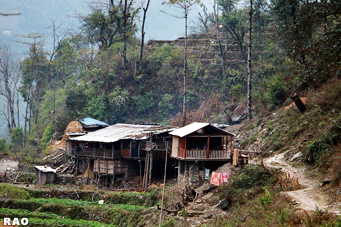 |
| Many Yakkhas
have settled in Darjeeling of India. the original homeland of the Kirants
people speaking the Yakkha language is the histroical five and ten majhiya
region in the southwestern part of Pallo or far Kirant area between the
Arun and Tamor rivers. Yakkhas adhere to the Kirant religion. |
|
Yolmo
Yolmowa
or simply Yolmo are the aboriginal people of Yolmo (Helambu transliterated)
region, which comprises the Northwest part of Sindhupalchok, Northeast
part of Nuwakot and Southeast part of Rasuwa districts. They have unique
culture, language, tradition and other ways of life.
| Percentage
of Ethnic Groups in Nepal |
2001
Census of Nepal, Source: Central Bureau of Statistics
| Chhetri |
15.8% |
| Brahman
- Hill |
12.7% |
| Magar |
7.1% |
| Tharu |
6.7% |
| Tamang |
5.6% |
| Newar |
5.5% |
| Muslim |
4.3% |
| Kami |
3.9% |
| Dadav |
3.9% |
| Rai |
2.8% |
| Gurung |
2.4% |
| Dhamai
/ Dholi |
1.7% |
| Limbu |
1.6% |
| Thakuri |
1.5% |
| Sarki |
1.4% |
| Teli |
1.3% |
|
| Charmar,
Harijan, Ram |
1.2% |
| Koiri |
1.1% |
| Kurmi |
0.9% |
| Sanyasi |
0.9% |
| Dhanuk |
0.8% |
| Musahar |
0.8% |
| Dusadh
/Pasan / Pasi |
0.7% |
| Sherpa |
0.7% |
| Sonar |
0.6% |
| Kewat |
0.6% |
| Brahman
Terai |
0.6% |
| Baniya |
0.6% |
| Gharti
Bhujel |
0.5% |
| Mallah |
0.5% |
| Kalwar |
0.5% |
 |
89.3% |
|
 |
| Credit:
NEFIN Nepal Federation of Indigenous Nationalities, 2007 |
 |
 |
Externe
Links |
top
|
Nepal
Maps
|
 |
| more information |
 |
 |
|
Terai
|
|






